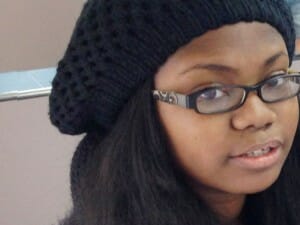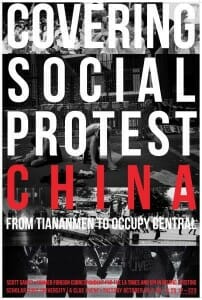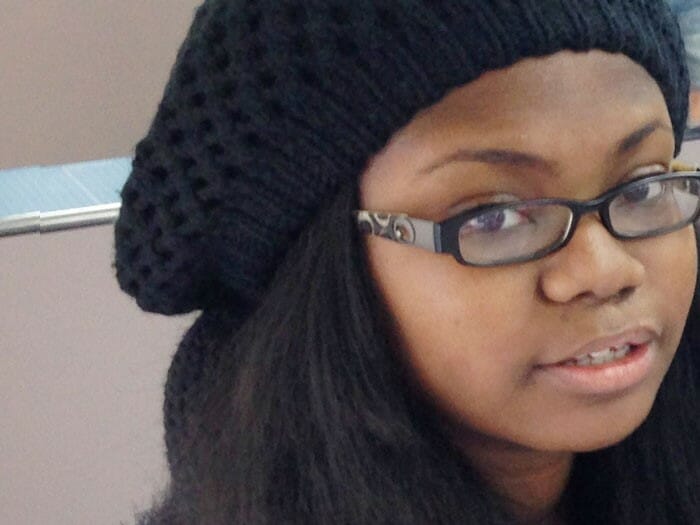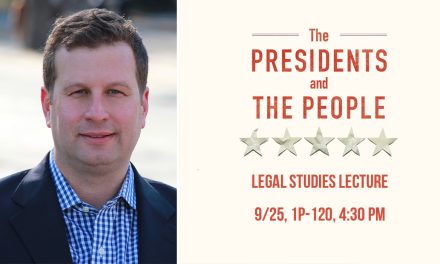
CSI Sophomore Samayra Williams designed a poster using images by Scott Savitt, a former LA Times and UPI correspondent who called her creation “the coolest poster I have ever seen my name on.”
Scott Savitt, former correspondent for the LA Times and United Press International (UPI) in Beijing, who covered the Tiananmen Square massacre in 1989, visited the College of Staten Island last semester to discuss these significant historic events of political dissent. This inspired Professor Ann Daly to create a project for her editorial design class where students made their own poster designs using several of Savitt’s images of Chinese protestors.
Professor Daly, who teaches design and digital media classes in the Department of Media Culture at CSI, was unsure if Savitt would allow his personal images of the Tiananmen Square massacre to be used by her students, but was “touched” that he was so open to the idea. “It was so generous of him,” she said of Savitt’s contributions to her class.
Her class performed rigorous research and were “very engaged with the material.” The students made use of their research and Savitt’s photos, as well as those from Creative Commons, and conceptualized designs for the project.
 “I usually create fictive events connected with current political topics, Professor Daly said, explaining the process through which her class usually goes for these projects. “But for this, we could not turn down the opportunity to use these memorable images and create designs for actual real-time use—as publicity to alert the community of this important speaking engagement.”
“I usually create fictive events connected with current political topics, Professor Daly said, explaining the process through which her class usually goes for these projects. “But for this, we could not turn down the opportunity to use these memorable images and create designs for actual real-time use—as publicity to alert the community of this important speaking engagement.”
The class, emboldened by the ability to use such important archival photographic material, took full advantage of this opportunity. At the end of the project, the class voted on one poster by sophomore Communications and Design/ Digital Media major Samayra Williams to send to Savitt. Savitt called it “the coolest poster I have ever seen my name on.”
Williams, who is planning on interning and eventually working for MTV as a designer after graduation, very meticulously worked on her design, beginning with her bold typeface. She also felt that “what Mr. Savitt went through was so inspiring—his images were very powerful—I didn’t want my design to interfere too much with his work.”
Professor Daly views Williams as an example of women embracing technology and the field of design and digital media, saying, “It is important that women and people of color embrace technology, including code,” explaining how while in the past the field was heavily male dominated she is happy to report that her classes are filled with students of both genders.
According to Professor Daly, her design students receive a “21st century education” in which they learn to brainstorm and collaborate with other students, to think critically, be adaptable, and problem solve with their design and digital media projects. Also, while the technical aspects of design are in the forefront of each class, her students also debate pressing topics such as ethics in design.
For her part, Williams found a group of students with whom she will continue to collaborate with for years to come. “We got lucky,” she said of the group of students in her class. “There was an exceptional rapport in this class. We don’t want to lose that.” Professor Daly is hopeful that a class Twitter assignment will facilitate this contact.
Savitt’s visit to CSI came at the invitation of Professor Christopher Anderson, who teaches journalism and media theory courses at CSI. The project reinforced the idea that editorial design is a field where designers and journalists can have an influence on how a particular message is encoded and may be received. Professor Daly stressed the opportunities in design and digital media for young graduates, since “every organization, museum, university, and not-for-profit needs designers.”
















